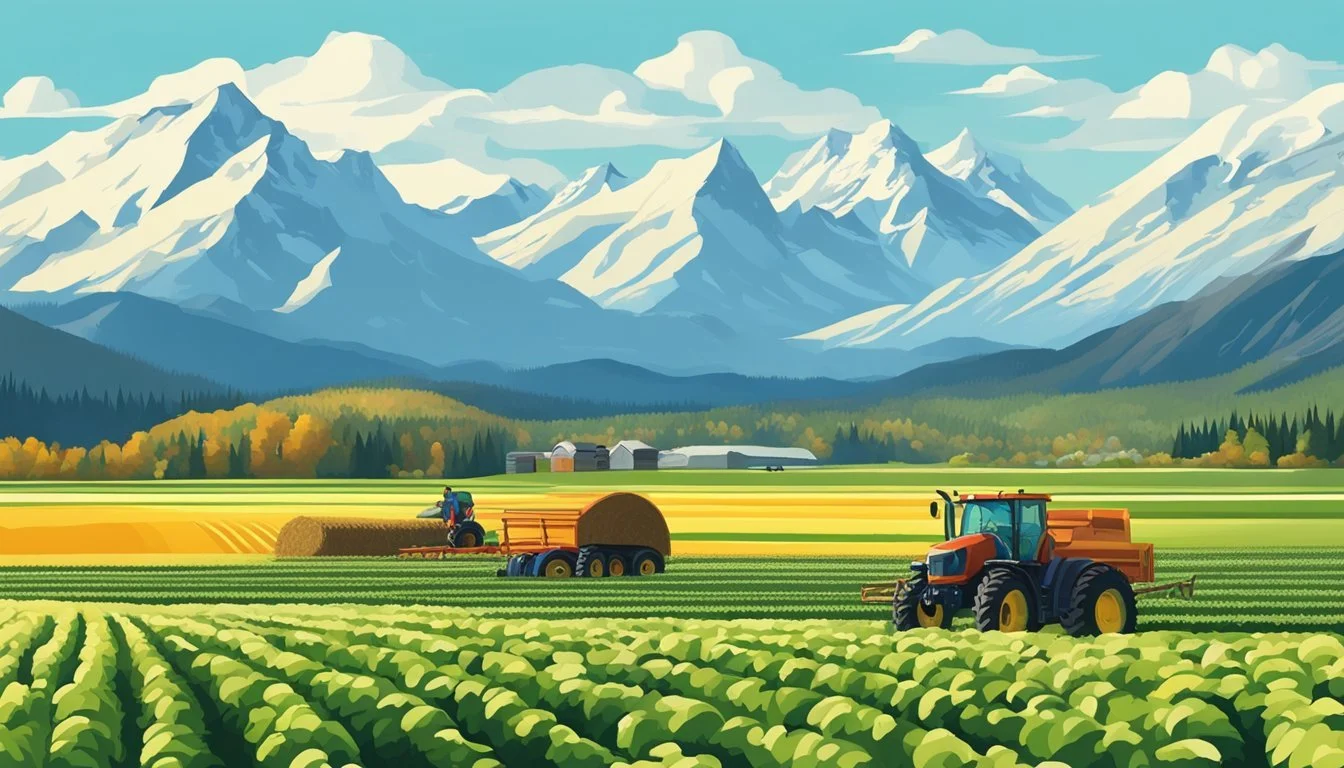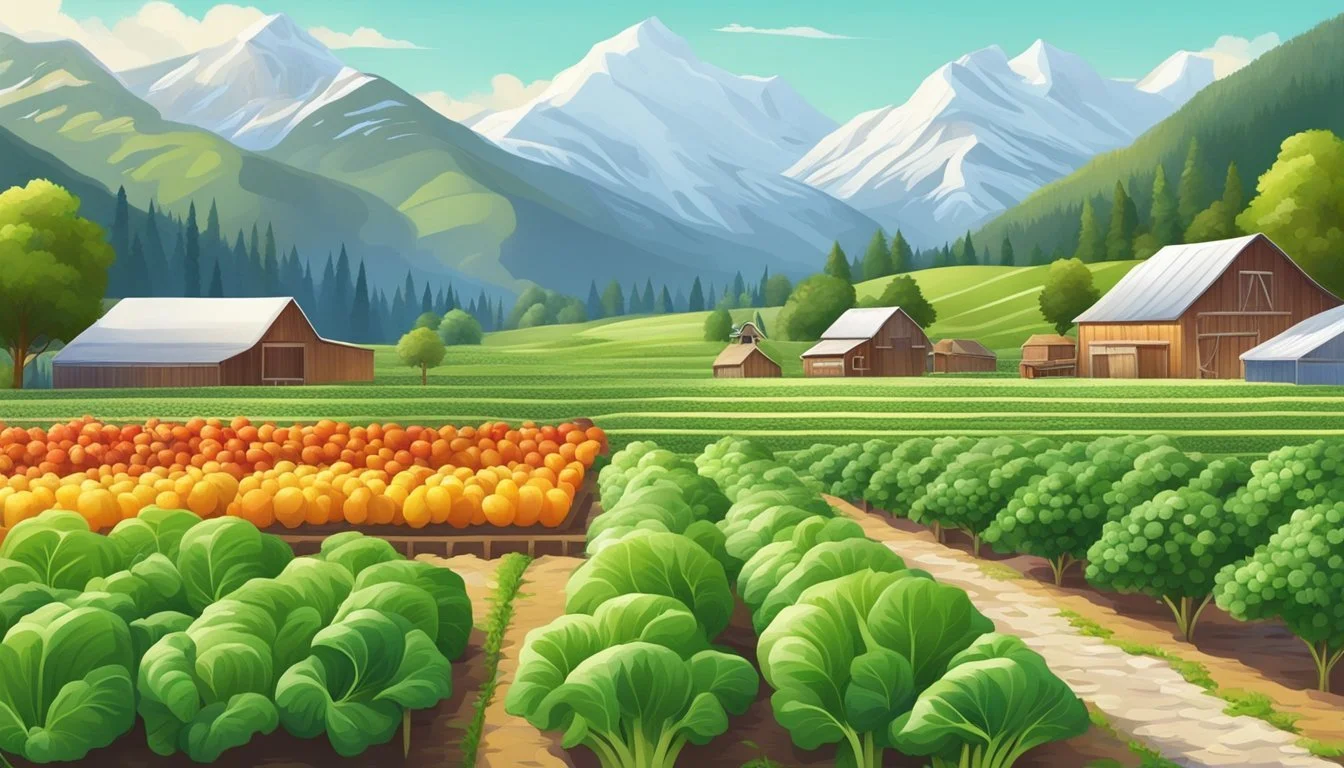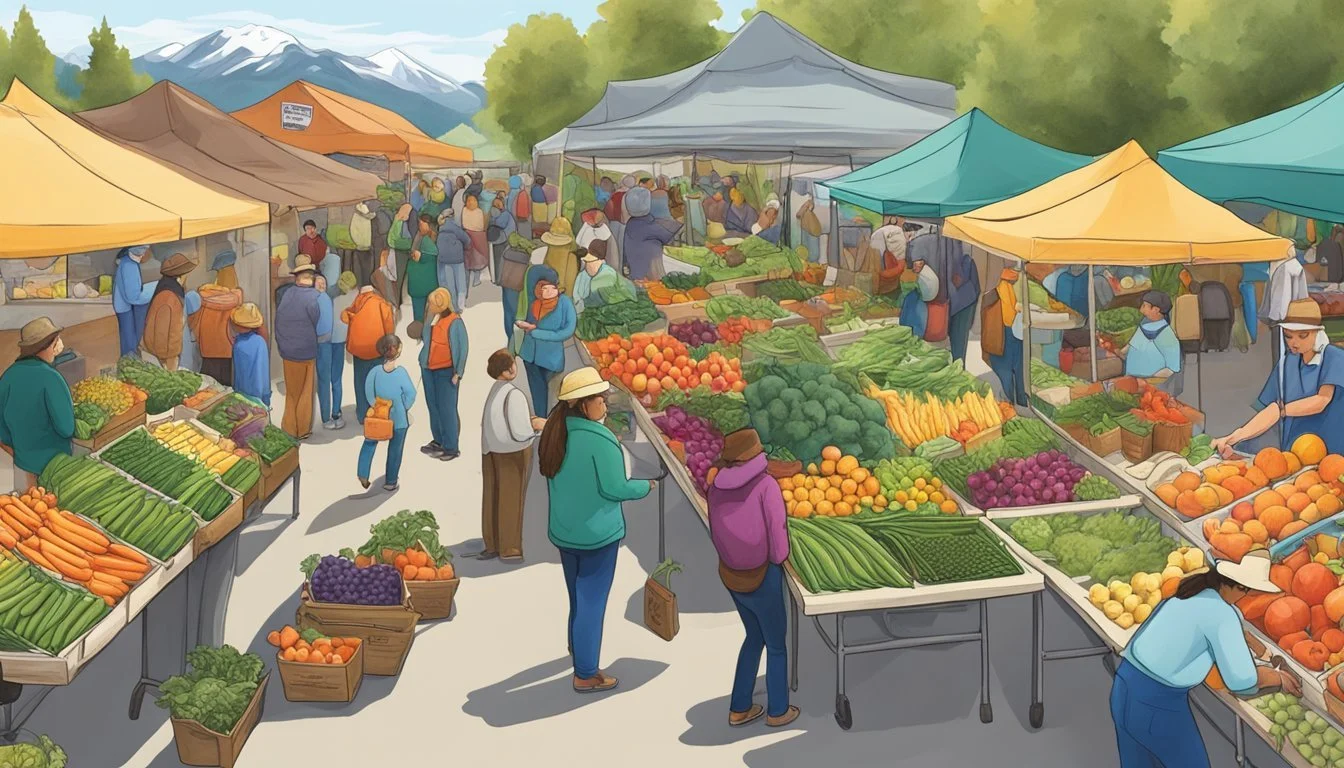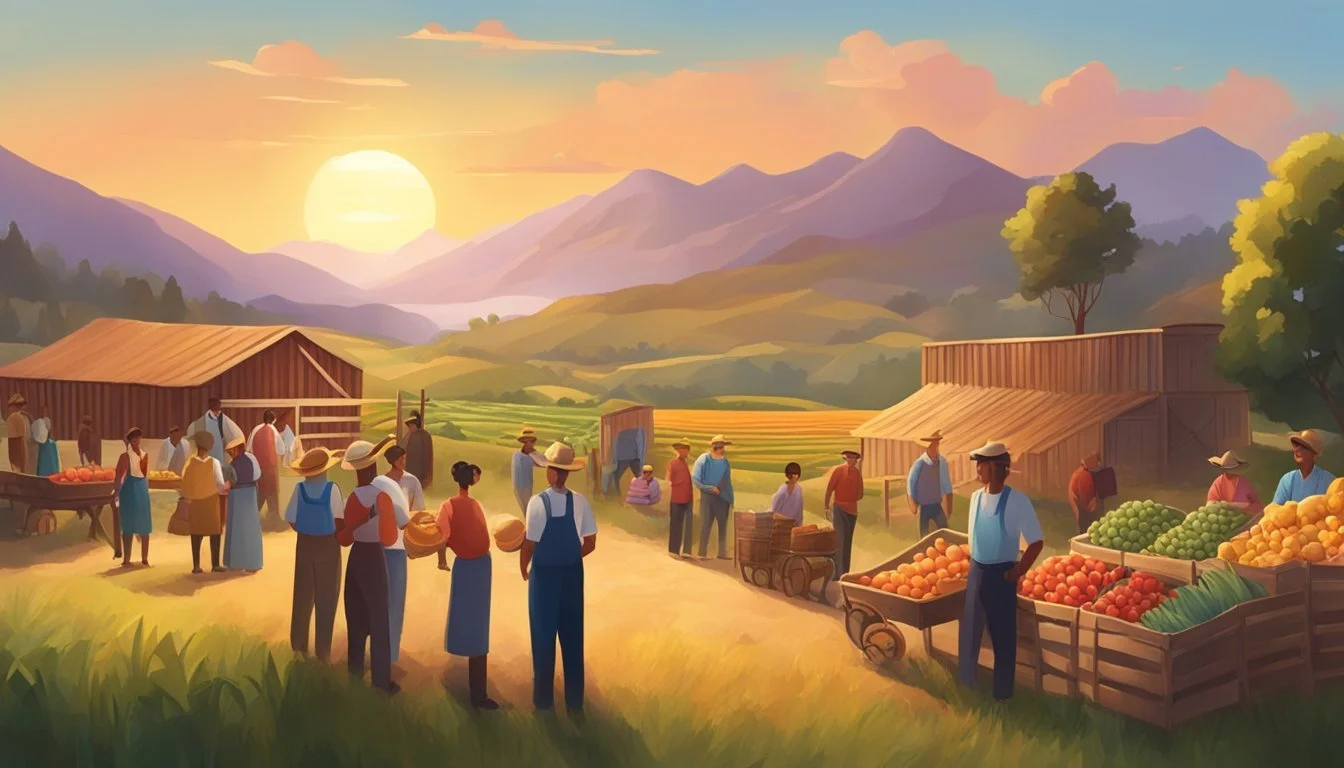Community Supported Agriculture (CSA) in Alaska
A Guide to Local Food Initiatives
Community Supported Agriculture, commonly known as CSA, is an agricultural practice that is gaining traction in Alaska. This model offers a mutually beneficial relationship between local farmers and community members. In essence, individuals purchase "shares" of a farm's anticipated harvest before the season begins. These early investments provide farmers with necessary capital to cover the initial costs of production. During the farming season, shareholders receive portions of the farm's output, typically on a weekly basis.
CSA in Alaska addresses the unique challenges of farming in the region, such as the short growing season and the high logistics costs associated with transporting goods to and across the state. By engaging in CSA, Alaskans are directly investing in their local food systems, enhancing food security, and ensuring a market for smaller farms. The practice fosters a closer connection between consumers and the source of their food, with members often gaining insight into farming practices and challenges faced by local growers.
The Alaskan landscape for CSA is as diverse as its agriculture, with farms offering an array of locally grown produce and even fresh-cut flowers. These CSA programs are tailored to the specific conditions and crop selections of the Alaskan climate, providing a fresh and seasonal array of goods to their communities. The model has not only bolstered economic support for farmers but also cultivated community engagement, signifying a resilient step towards sustainable local farming practices in Alaska's unique environment.
Understanding CSA
Community Supported Agriculture (CSA) offers a means for consumers to buy local, seasonal produce directly from farmers in Alaska. This section explores the basics of the CSA model, the benefits it brings to the community, and the challenges it faces.
CSA Model Basics
In the CSA model, consumers purchase shares at the start of the growing season. This model functions as a partnership, where the shareholders receive periodic distributions of the farm's produce. They pay in advance, providing the farmer with upfront capital to cover anticipated costs for the season.
Benefits of Community Supported Agriculture
Community Supported Agriculture provides numerous benefits:
Direct support to farmers: By providing upfront payment, consumers help farmers with the early season financial requirements.
Fresh and local produce: Shareholders receive a supply of fresh, local produce throughout the Alaska growing season.
Strengthened community ties: CSA fosters closer connections between Alaskan farmers and their surrounding communities.
Environmental sustainability: The focus on local and seasonal produce reduces the carbon footprint associated with long-distance transportation.
Challenges and Considerations
While advantageous, CSA models also face some challenges:
Operational complexity: Managing a CSA requires significant planning and resources from farmers.
Consumer expectations: Shareholders may have to adjust to the seasonality of produce and the lack of choice that comes with this model compared to traditional grocery stores.
Weather dependence: The success of a CSA can depend heavily on favorable weather conditions, making it potentially risky for both consumers and farmers.
Alaskan CSA Farms
Community Supported Agriculture (CSA) in Alaska provides a symbiotic relationship between local farms and their communities. By purchasing CSA shares, Alaskans receive fresh, seasonal produce, while directly supporting the sustainability and growth of local agriculture.
CSA Farms in Anchorage
Anchorage boasts a vibrant CSA community with various options for residents to source local, fresh produce. Farms in Anchorage offer weekly distributions that may include vegetables, fruits, herbs, and sometimes even flowers. Notable for their commitment to urban farming, these farms help maintain food security within the city.
Spring Creek Farm
Spring Creek Farm, part of Alaska Pacific University, plays a pivotal role in the CSA ecosystem. Offering shares of fresh produce during the growing season, the farm fosters community involvement and sustains itself through these shareholder partnerships. Education remains at the heart of its mission, emphasizing the importance of sustainable farming practices.
Ester Community Agriculture
The community of Ester supports a local farm that is committed to providing residents with organic, sustainably grown produce. Although smaller in scale compared to larger farms, its CSA program ensures that shareholders are an integral part of the farm's success, receiving a portion of the harvest while also engaging in community events and volunteer opportunities.
Farms in Palmer and Interior Regions
Palmer and the surrounding Interior regions host a network of CSA farms that contribute to Alaska's agricultural diversity. These farms typically offer CSA memberships with the promise of fresh, locally grown produce throughout the season. They are essential to promoting regional food self-sufficiency and strengthening the local economy by keeping consumer dollars within the community.
Joining a CSA Program in Alaska
When residents of Alaska join a CSA program, they invest in their local agricultural community, ensuring a season-long supply of fresh produce. Consumers have options for share sizes and pick-up locations, providing flexibility and convenience.
How to Choose a CSA
Selecting the right CSA program involves assessing a few key factors specific to the consumer's needs. One should consider the variety of produce offered and whether organic practices are important. They should also assess the pick-up locations to ensure they are accessible. Consumers are encouraged to research and contact local farms like Alaska Botanical Garden or Spring Creek Farm to understand their growing practices and community involvement.
Understanding Share Options
CSA programs in Alaska typically offer a variety of share options. These can include:
Full Shares: Suitable for families or those who consume plenty of vegetables; usually enough for 3-4 people.
Half Shares: Ideal for individuals or small households; provides a smaller quantity of produce.
Prices for these shares are set by the farms at the beginning of the season, with consumers paying upfront. This early investment supports farms when they purchase seeds and supplies, and in return, members receive weekly distributions of fresh produce throughout the harvesting season.
Community Engagement and Support
Being part of a CSA program extends beyond receiving weekly produce. Members often gain educational insights into sustainable farming practices, and they get an opportunity to engage in various farm-related events. CSA members help in building regional food security and support local farmers, ensuring the community has regular access to fresh, local, and seasonal products.
Benefits of CSA to Local Agriculture
Community Supported Agriculture (CSA) programs in Alaska provide critical support to local agriculture, enhancing food security, empowering local farmers, and fostering environmental sustainability.
Promoting Food Security
CSA initiatives are pivotal in bolstering food security in Alaska, where remoteness can often lead to supply chain challenges. By facilitating direct access to fresh, locally-grown produce, residents have a reliable source of nutritious food. This is especially significant during the harsher months when import-dependent supplies may be disrupted.
Reliable access to food during winter months
Diverse offerings that include cold-hardy crops suited to Alaska's climate
Supporting Local Farmers
The direct financial support from CSA members to Alaskan farmers plays a vital role in sustaining the local agricultural economy. Farmers receive upfront payments for their crop shares, which helps in planning and covering the initial costs of cultivation.
Upfront payments that improve cash flow for farmers
Stable market reduces uncertainty and financial risk
Environmental Impact and Sustainability
CSAs support sustainable agricultural practices that are more in tune with Alaska’s unique environment. Reduced transportation distances for food and the use of eco-friendly farming methods minimizes the environmental footprint.
Local production cuts down on carbon emissions from long-distance transportation
Sustainable practices lead to improved soil health and reduced chemical use
CSA Farm Operations
In Alaska's CSA farms, meticulous planning and strategic financial approaches are key to sustaining operations that deliver fresh, seasonal produce to the community.
Seasonal Crop Planning
CSA farms in Alaska prioritize seasonal crop planning to ensure a diverse and continuous supply of produce. These farms meticulously chart out planting schedules accounting for Alaska's unique climate, aiming to maximize yield and variety. The focus is on seasonally appropriate crops, starting from hardy greens in spring to root vegetables that can withstand colder temperatures later in the season.
Income and Pricing Strategies
To maintain financial viability, CSA farms employ various income and pricing strategies. Shares are priced to reflect the value of the fresh produce offered while considering the input costs. Income is generated primarily at the start of the season when members purchase shares, which provides the upfront capital needed for seeds, equipment, and labor.
Share Pricing Examples:
Basic Share: Suitable for small households, includes a weekly distribution of vegetables.
Full Share: Designed for larger households or those with a vegetarian diet.
Farmers balance affordability for members with the need to sustain their operations, often providing sliding scale prices or payment plans to accommodate different income levels.
Community-Supported Models
CSA farms rely on community-supported models to foster direct and meaningful connections between farmers and consumers. Members commit to a season of produce upfront, which strengthens regional food security and supports the local economy. This model rewards members with a regular allotment of fresh, local, and seasonal produce, reflecting the harvest of their invested farm.
Community Engagement Strategies:
Work Days: Some farms offer a discount to members who contribute labor.
Farm Events: Farms may host harvest festivals or cooking demonstrations.
Agricultural Practices in CSA
Community Supported Agriculture in Alaska focuses on practices that promote sustainability and ecological balance, with a strong emphasis on maintaining biodiversity and soil health within its challenging climatic conditions.
Organic and Sustainable Farming
In CSA initiatives, farmers often employ organic farming techniques to produce vegetables, herbs, and greens. They avoid synthetic pesticides and fertilizers, instead opting for natural alternatives to manage pests and enrich the soil. Many Alaskan CSA farms are moving towards sustainable models that prioritize the ecosystem's long-term health, reducing their carbon footprint and conserving water.
Crop Variety and Rotation
Crop rotation is a critical component of CSA agricultural practices, combating pest outbreaks and soil nutrient depletion. CSA farmers meticulously plan their crop cycles, often incorporating a diverse array of produce to fulfill their shareholders' weekly shares. This includes a variety of:
Vegetables: such as tomatoes, cucumbers, and peppers
Herbs: like basil, parsley, and thyme
Greens: encompassing lettuce, spinach, and kale
This diversity ensures a rich diet for consumers and promotes a resilient farming system.
Soil Health and Preservation
Preserving soil health is paramount in CSA farming and involves practices like composting and cover cropping. Farmers enrich the soil with organic matter to bolster its structure and fertility. They adhere to methods that prevent erosion and compaction, ensuring that the land remains productive for future generations and continues to provide high-quality gardening produce for the community.
Community Involvement
In Alaska, Community Supported Agriculture (CSA) is a testament to the strength of community bonds and the dedication of Alaskans to sustainable agriculture. This involvement is channelled through the roles consumers play, educational efforts, and the opportunities for volunteerism.
Roles of Consumers in CSA Farms
Consumers are integral to the success of CSA farms, providing financial support and consistent markets for farm products. Purchasing shares at the start of the season, they help in covering initial production costs and share the risks associated with farming. Through their commitment, consumers enjoy regular distributions of fresh produce, thus creating a direct farm-to-table pipeline that benefits both the consumer and the farmer by removing the middleman.
Education and Outreach Programs
Education is a key component of CSA farms, with many providing outreach programs to increase awareness about the benefits of locally grown food and sustainable agriculture methods. These programs aim to inform both members and the general public about the processes involved in farming and the importance of supporting local agriculture. By participating in these education initiatives, members become more informed about the agricultural process and can make more conscious choices about their food consumption.
Volunteer Opportunities and Events
Many CSA farms offer various volunteer opportunities and organize events to deepen community involvement. These can include:
Planting and Harvest Days: Community members are invited to assist with planting crops or harvesting produce, providing hands-on experience.
Farm Tours: These serve as educational tools to show consumers where and how their food is produced.
Through these events, CSA farms strengthen their ties with the community and open avenues for further collaboration and understanding between producers and consumers.
Support for New and Beginning Farmers
For new and beginning farmers in Alaska, engaging with Community Supported Agriculture (CSA) becomes a gateway to establishing one's agricultural roots. Through CSA, these farmers can receive critical support early in their careers, from hands-on training to essential networking opportunities.
Training and Mentorship Programs
Training and mentorship programs are a cornerstone for CSA farms in providing practical education to beginning farmers. Organizations such as Alaska Pacific University emphasize the importance of direct farm experience and offer a variety of instruction and mentorship opportunities. These programs often include everything from seasonal planting techniques to managing farm finances.
Access to Land and Resources
Access to land and necessary resources is another crucial aspect for the success of new farmers. Community Supported Agriculture in Alaska assists by offering avenues for land access and shared resources. Beginning farmers might benefit from various CSA models that offer access to plots of land, or they may participate in cooperative purchase of farming tools and supplies.
Community Networks and Collaborations
Strong community networks and collaborations foster an environment of support and shared knowledge among farmers. CSA shareholders and local farms establish connections that can lead to collaborations, further helping new farmers integrate into the local food system. Networking through CSA can provide emerging farmers with marketing opportunities, shared labor, and access to a wider customer base.










